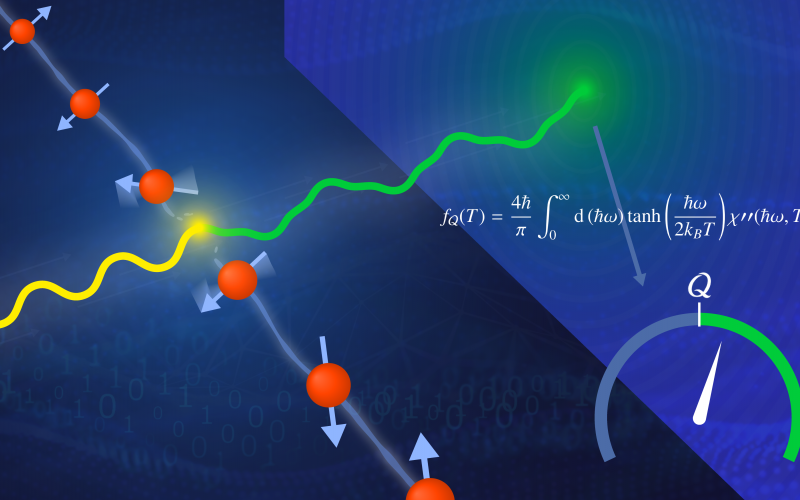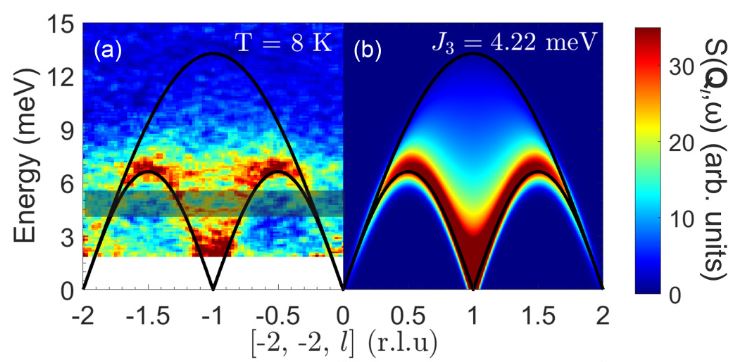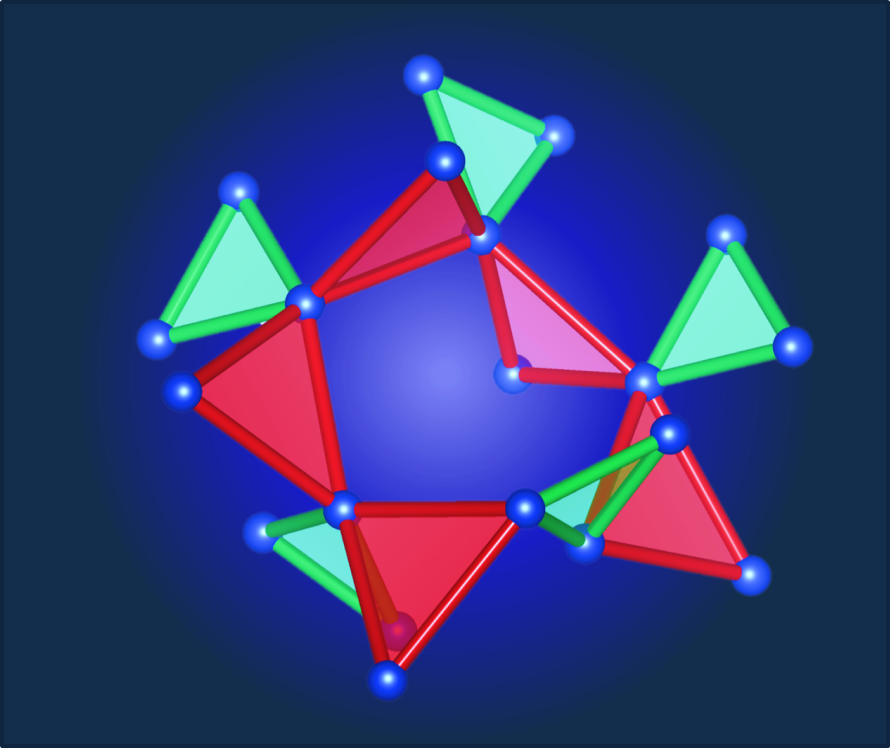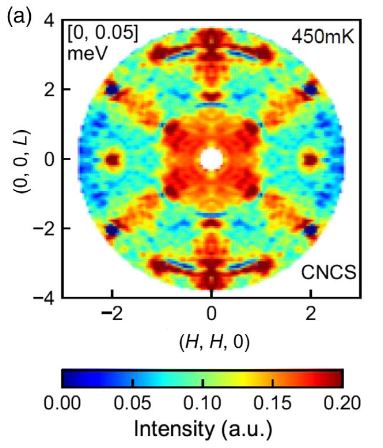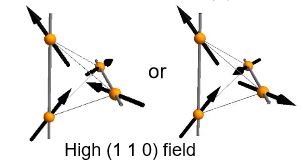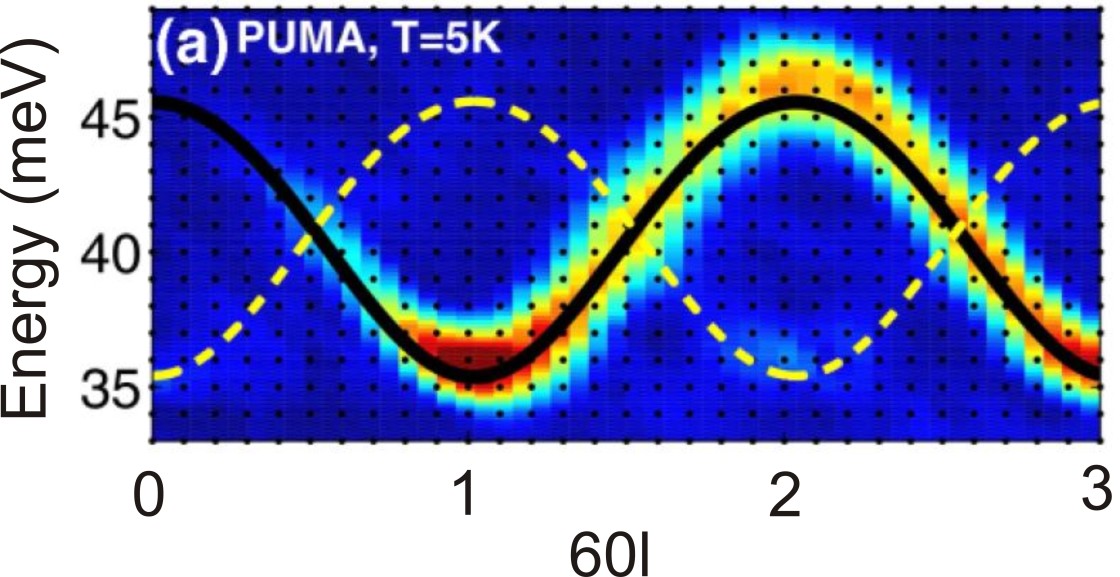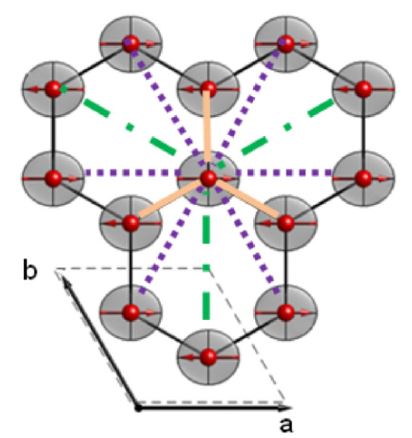Institute Quantum Phenomena in Novel Materials
Quantum magnetism and frustrated magnets
In the following we present selected examples of recent research in the fields of quantum magnetism and frustrated magnets
For a full list of publications of our institute click here
Witnessing entanglement in quantum magnets
We demonstrate how quantum entanglement can be directly witnessed in the quasi-1D Heisenberg antiferromagnet KCuF3. We apply three entanglement witnesses—one tangle, two tangle, and quantum Fisher information—to its inelastic neutron spectrum and compare with spectra simulated by finite-temperature density matrix renormalization group (DMRG) and classical Monte Carlo methods. We find that each witness provides direct access to entanglement. Of these, quantum Fisher information is the most robust experimentally and indicates the presence of at least bipartite entanglement up to at least 50 K, corresponding to around 10% of the spinon zone-boundary energy. We apply quantum Fisher information to higher spin-S Heisenberg chains and show theoretically that the witnessable entanglement gets suppressed to lower temperatures as the quantum number increases. Finally, we outline how these results can be applied to higher dimensional quantum materials to witness and quantify entanglement.
A Scheie, P Laurell, AM Samarakoon, B Lake, SE Nagler, GE Granroth, S Okamoto, G Alvarez, DA Tennant, Phys Rev B 103 (2021) 224434
See also the associated highlight report
Weak three-dimensional coupling of Heisenberg quantum spin chains in SrCuTe2O6
We studies the magnetic Hamiltonian of the Heisenberg quantum antiferromagnet SrCuTe2O6 by inelastic neutron scattering above and below the magnetic transition temperatures at 8 and 2 K. The high-temperature spectra reveal a characteristic diffuse scattering corresponding to a multispinon continuum, confirming the dominant quantum spin chain behavior due to the third neighbor interaction. The low-temperature spectra exhibit sharper excitations at energies <1.25 meV, which can be explained by considering a combination of weak antiferromagnetic first nearest neighbor interchain coupling J1 and even weaker ferromagnetic second nearest neighbor J2. These results suggest that SrCuTe2O6 is a highly one-dimensional Heisenberg system with three mutually perpendicular spin chains coupled by a weak ferromagnetic J2 in addition to the antiferromagnetic J1.
S Chillal, ATMN Islam, P Steffens, R Bewley, B. Lake, Phys Rev B 104 (2021) 144402
Evidence for a three-dimensional quantum spin liquid in PbCuTe2O6
Quantum spin liquids are very rare and are confined to a few specific cases where the interactions between the magnetic ions cannot be simultaneously satisfied (known as frustration). Lattices with magnetic ions in triangular or tetra-hedral arrangements, which interact via isotropic antiferromagnetic interactions, can generate such a frustration. Three-dimensional isotropic spin liquids have mostly been sought in materials where the magnetic ions form pyrochlore or hyperkagome lattices. Here we present a three-dimensional lattice called the hyper-hyperkagome that enables spin liquid behaviour and manifests in the compound PbCuTe2O6. Using a combination of experiment and theory, we show that this system exhibits signs of being a quantum spin liquid with no detectable static magnetism together with the presence of diffuse continua in the magnetic spectrum suggestive of fractional spinon excitations.
S Chillal, Y Iqbal, HO Jeschke, JA Rodriguez-Rivera, R Bewley, P Manuel, D Khalyavin, P Steffens, R Thomale, ATMN Islam, J Reuther, B Lake, Nat. Commun. 11 (2020) 2348
See also the associated highlight report
Dispersions of many-body Bethe strings
Complex bound states of magnetic excitations, known as Bethe strings, were predicted almost a century ago to exist in one-dimensional quantum magnets. The dispersions of the string states have so far remained the subject of intensive theoretical studies. By performing neutron scattering experiments on the one-dimensional Heisenberg–Ising antiferromagnet SrCo2V2O8 in high longitudinal magnetic fields, we revealed in detail the dispersion relations of the string states over the full Brillouin zone, as well as their magnetic field dependencies. Furthermore, the characteristic energy, the scattering intensity and linewidth of the observed string states exhibit excellent agreement with our precise Bethe–ansatz calculations. Our results establish the important role of string states in the quantum spin dynamics of one-dimensional systems, and will invoke studies of their dynamical properties in more general many-body systems.
AK Bera, J Wu, W Yang, R Bewley, M Boehm, J Xu, M Bartkowiak, O Prokhnenko, B Klemke, ATMN Islam, JM Law, Z Wang, and B Lake, Nat. Phys. (2020) doi: 10.1038/s41567-020-0835-7
See also the associated highlight report
Order out of a Coulomb Phase and Higgs Transition in Nd2Zr2O7
The pyrochlore material Nd2Zr2O7 with an “all-in-all-out” (AIAO) magnetic order shows novel quantum moment fragmentation with gapped flat dynamical spin ice modes. The parametrized spin Hamiltonian with a dominant frustrated ferromagnetic transverse term reveals a proximity to a U(1) spin liquid. We studied the magnetic excitations of Nd2Zr2O7 above the ordering temperature (TN) using high-energy-resolution inelastic neutron scattering. Our findings relate the magnetic ordering of Nd2Zr2O7 with the Higgs mechanism and provide explanations for several previously reported experimental features.
J Xu, O Benton, ATMN Islam, T Guidi, G Ehlers, and B Lake, Phys. Rev. Lett. 124 (2020) 097203
Field-induced quantum spin-1/2 chains and disorder in Nd2Zr2O7
Neutron scattering study on the quantum spin ice candidate Nd2Zr2O7 in magnetic fields along the (1 1 0) direction give evidence for field-induced one-dimensional correlations and disorder. The pyrochlore lattice is completely separated into orthogonal sets of chains which is in strong contrast to classical spin ice and surprising for an “all-in-all-out” (AIAO) ordered magnet with a non-Ising Hamiltonian. Our mean-field and Monte Carlo simulations reveal that the (1 1 0) field induces a transition from the AIAO order to a “2-in-2-out” disordered state with interactions between the two sets of chains cancelled out, resulting in disorder and quantum spin-1/2 XYZ chains.
J Xu, ATMN Islam, I Glavatskyy, M Reehuis, J-U Hoffmann, B Lake, Phys. Rev. B 98 (2018) 60408, Open access version 
J Xu, O Benton, VK Anand, ATMN Islam, T Guidi, G Ehlers, E Feng, Y Su, A Sakai, P Gegenwart, B Lake, Physical Review B 99 (2019) 144420, Open Access Version 
Hamiltonian of the S = 1/2 dimerized antiferromagnetic-ferromagnetic quantum spin chain BaCu2V2O8
The novel quantum magnet BaCu2V2O8 was recently discovered to be a rare physical realization of a onedimensional antiferromagnetic-ferromagnetic dimerized chain which displays strongly correlated phenomena at elevated temperatures. Here, static susceptibility and inelastic neutron scattering data are compared to several theoretical models. An analytical relation for the dynamic structure factor of the complex unit cell of BaCu2V2O8 is derived and used to identify the intrachain exchange paths.
ES Klyushina, ATMN Islam, JT Park, EA Goremychkin, E Wheeler, B Klemke, B Lake, Phys. Rev. B 98 (2018) 104413, Open Access Version 
ES Klyushina, AC Tiegel, B Fauseweh, ATMN Islam, JT Park, B Klemke, A Honecker, GS Uhrig, SR Manmana, B Lake, Phys. Rev. B 93 (2016) 241109(R), Open Access Version 
Physical realization of a quantum spin liquid based on a complex frustration mechanism
Unlike conventional magnets where the magnetic moments are partially or completely static in the ground state, in a quantum spin liquid they remain in collective motion down to the lowest temperatures. In the case of magnets with isotropic interactions, spin-liquid behaviour is sought in simple lattices with antiferromagnetic interactions that favour antiparallel alignments of the magnetic moments and are incompatible with the lattice geometries. Despite an extensive search, experimental realizations remain very few. Here we investigate the novel, unexplored magnet Ca10Cr7O28, which has a complex Hamiltonian consisting of several different isotropic interactions and where the ferromagnetic couplings are stronger than the antiferromagnetic ones. We show both experimentally and theoretically that it displays all the features expected of a quantum spin liquid. Thus spin-liquid behaviour in isotropic magnets is not restricted to the simple idealized models currently investigated, but can be compatible with complex structures and ferromagnetic interactions.
C Balz, B Lake, J Reuther, H Luetkens, R Schönemann, T Herrmannsdörfer, Y Singh, ATMN Islam, EM Wheeler, JA Rodriguez-Rivera, T Guidi, GG Simeoni, C Baines, H Ryll, Nature Physics 12 (2016) 942, Open Access Version 
See also the associated highlight report
follow-up papers:
C Balz, B Lake, ATMN Islam, Y Singh, JA Rodriguez-Rivera, T. Guidi, EM Wheeler, GG Simeoni, H Ryll, Phys. Rev. B 95 (2017) 174414, Open Access Version 
C Balz, B Lake, M Reehuis, ATMN Islam, O Prokhnenko, Y Singh, P Pattison, S Tóth, J. Phys.: Condens. Matter 29 (2017) 225802
J Sonnenschein, C Balz, U Tutsch, M Lang, H Ryll, JA Rodriguez-Rivera, ATMN Islam, B Lake, J Reuther, Physical Review B 100 (2019) 174428
Investigation of the spin-1 honeycomb antiferromagnet BaNi2V2O8 with easy-plane anisotropy
Using dc susceptibility measurements and inelastic neutron scattering techniques, we found that the magnetic excitation spectrum of the 2D, S = 1 honeycomb antiferromagnet BaNi2V2O8 is found to be dispersionless within experimental resolution between the honeycomb layers, while it disperses strongly within the honeycomb plane. The magnetic excitations are compared to linear spin-wave theory allowing the Hamiltonian to be determined. The interplane coupling Jout is four orders of magnitude weaker than the intraplane interactions, confirming the highly two-dimensional magnetic behavior of this compound. The sizes of the energy gaps are used to extract the magnetic anisotropies and reveal substantial easy-plane anisotropy and a very weak in-plane easy-axis anisotropy. Together these results reveal that BaNi2V2O8 is a candidate compound for the investigation of vortex excitations and Berezinsky-Kosterliz-Thouless phenomenon.
ES Klyushina, B Lake, ATMN Islam, JT Park, A Schneidewind, T Guidi, EA Goremychkin, B Klemke, M Månsson Phys. Rev. B 96, 214428 (2017)
Spinon confinement in the one-dimensional Ising-like antiferromagnet SrCo2V2O8
For quasi-one-dimensional quantum spin systems theory predicts the occurrence of a confinement of spinon excitation due to interchain couplings. Here we investigate the system SrCo2V2O8, a realization of the weakly coupled Ising-like XXZ antiferromagnetic chains, by terahertz spectroscopy with and without applied magnetic field. At low temperatures a series of excitations is observed, which split in a Zeeman-like fashion in an applied magnetic field. These magnetic excitations are identified as the theoretically predicted spinon-pair excitations.
A.K. Bera, B. Lake, F.H.L. Essler, L. Vanderstraeten, C. Hubig, U. Schollwöck, A.T.M.N. Islam, A. Schneidewind, and D.L. Quintero-Castro, Phys. Rev. B 96, (2017) 054423, Editor’s choice
Z Wang, M Schmidt, AK Bera, ATMN Islam, B Lake, A Loidl, J Deisenhofer, Phys. Rev. B 91 (2015) 140404(R)

